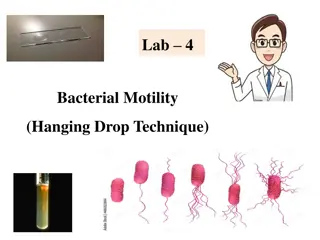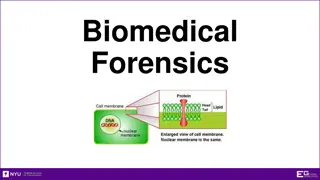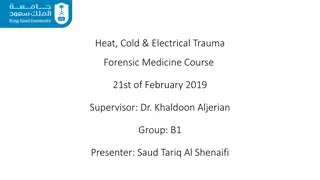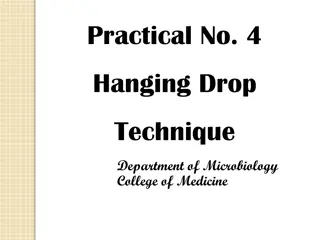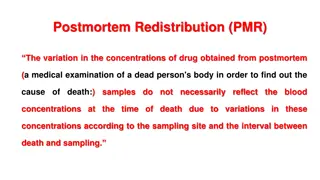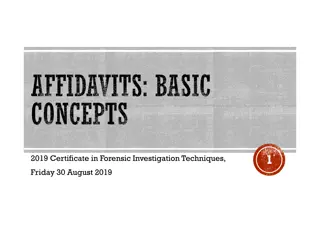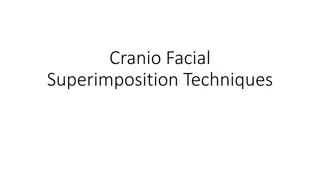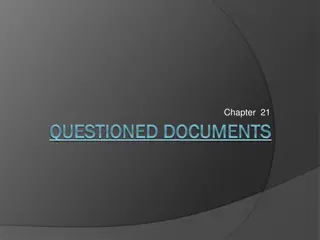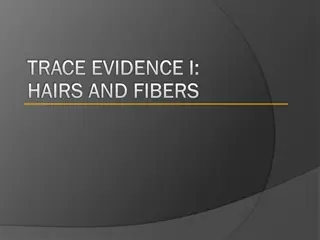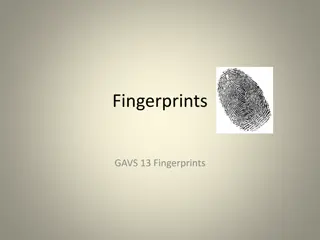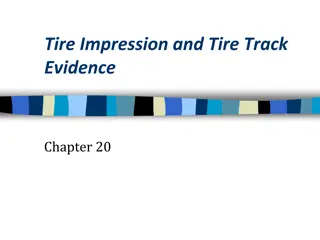Understanding Hanging in Forensic Medicine
Hanging is defined as a violent asphyxial death where air entry to the lungs is blocked by neck constriction due to body suspension. Types include complete and incomplete hanging, with varying degrees of body suspension. Ligatures and signs/symptoms of hanging are discussed, along with treatment measures in case of survival post-suspension.
Download Presentation

Please find below an Image/Link to download the presentation.
The content on the website is provided AS IS for your information and personal use only. It may not be sold, licensed, or shared on other websites without obtaining consent from the author. Download presentation by click this link. If you encounter any issues during the download, it is possible that the publisher has removed the file from their server.
E N D
Presentation Transcript
AGADTANTRA VYAVAHAR AYURVED EVUM VIDHIVAIDYAK HANGING Name Prachi Barmase Roll No. 05 Batch 3rdBAMS(2017)
DEFINITION Hanging is defined as the mode of violent asphyxial death in which entry of air to the lungs is prevented by constriction of the neck because of suspension of the body by a ligature tied round the neck, so that the weight of the body is the constricting force on the neck (i.e.,the constricting force is endogenous). It is not essential that the complete body weight should constrict the neck, death is possible even if a part of body weight constricts neck, because 3-5 kg weight is sufficient to constrict and occlude the arteries.
Types - Hanging Complete Incomplete
1. Complete hanging-(hanging from high point of suspension) There is complete suspension of body & therefore feet are above the ground and therefore complete body weight constricts the neck. 2. Incomplete/Partial hanging (hanging from low point of suspension) There is only partial suspension and since feet or some other body part is touching the ground, only a part of body weight - sometimes the weight of head only i.e., 5-6 kg, constricts neck. In this condition -Toes may be just touching the ground. Feet may be resting on the ground. Knees may be touching the ground. Body may be in reclining posture
LIGATURE It refers to any material used for suspension of body from neck, eg, nylon rope, moonj rope, electric wire, iron wire, cycle chain, saree, shirt, dupatta, belt, neck-tie, sacred thread etc.
SIGNS & SYMPTOMS a) Death in case of complete hanging is almost instantaneous and many consider it to be a method causing sudden death (i.e., why it is the method of capital punishment in India). b) In case of partial constriction of neck, there is i. Return to memory of forgotten events(abreaction). ii. Mental confusion. iii. Loss of power. iv. Auditory (ringing in ears) & visual(seeing flashes of light) hallucinations. v. Convulsions.
TREATMENT If the person is living after suspension - Untie the ligature. Pull tongue & give artificial respiration. Shift to hospital & give artificial respiration using mixture of O2, & CO2. Cerebral & cardiac stimulants. Treat hypotension, hypothermia & other complications. Venesection is useful to relieve venous congestion by oozing out blood.
MECHANISM OF DEATH As Per POLSON - A weight of 2 kg - can constrict jugular veins. A weight of 3-5 kg - can constrict carotid arteries, A weight of 15 kg - can constrict trachea. A weight of 16-18 kg - can constrict vertebral artery.(This explains why death can occur even in partial hanging)
CAUSES OF DEATH IN HANGING 1. Asphyxia (due to compression of larynx & trachea, forcing up of tongue against posterior pharyngeal wall & closure of epiglottis). 2. Cerebral anoxia 3. Venous congestion (due to compression of jugular veins). 4. Neurogenic shock (due to compression of carotid sinuses or vagus nerve). 5. Fracture or dislocation of cervical vertebrae. 6. Injury to spinal cord. 7. Injury to pons or medulla.
FATAL PERIOD In case of complete hanging, death is almost instantaneous. In case of partial constriction of neck, death may be delayed by 2-5 min. (Death is earlier in case of fracture dislocation of cervical vertebrae & asphyxia, and is delayed in venous congestion).
POST-MORTEM APPEARANCE Is described as Local General External Internal External Internal
LOCAL EXTERNAL P.M. APPEARANCE Externally on the local area i.e., neck, there is a ligature mark which is present above thyroid, is oblique, symmetrical and incomplete TYPES OF LIGATURE MARK Ligature mark on the neck may be 1. Typical ligature mark 2. Atypical ligature
APPEARANCE OF LIGATURE MARK Position The ligature mark is above thyroid in 80% cases of hanging. Surface -The surface of mark is abraded/contused or as contused abrasion. Sometimes the mark is patterened i.e., the pattern of ligature is reproduced on the skin. Colour -The mark is initially yellowish brown, later it becomes dark brown, parchment like & hard. Margins -show petechial haemmorrhages. Surrounding skin -show few petechial haemmorrhages. Depth -of mark is variable and depends upon the type of ligature
VARIATIONS IN THE LIGATURE MARK 1) Mark may be below thyroid - if hanging is partial ( mark in this case is usually transverse). 2) Mark may be circular when multiple rounds of ligature made around neck & no knot is tied. 3) Mark absent- a) Mark is usually absent on posterior part of neck, because of thick neck musculature and hair intervening. b) Mark is usually absent at site of knot. c) Mark may be absent due to intervening shirt collar. d) Mark may be absent on anterior aspect of neck, because of long beard. e) Mark may be absent/patchy/faint, if soft material is used as ligature.
FACTORS INFLUENCING THE LIGATURE MARK 1. Type of suspension 2. Type of ligature 3. Mark is better, if knot is tight 4. Type of knot- a) fixed knot b) running knot 5. Site of knot 6. Multiple rounds of ligature 7. Weight of body 8. Time of suspension
LOCAL INTERNAL P. M. APPEARANCE P.M. findings are different in routine versus judicial hanging as in the later there is a sudden fall of 10-15 feet. Findings in routine hanging - 1. Under the ligature mark, there is dry, white glistening (shining) pad of fat. 2 In about 5-10% there may be laceration of muscles of the neck, especially platysma and sternomastoid. 3.Laceration of blood vessel walls is rare (in only 5-10%). 4.Usually haemmorrhage in cervical lymph nodes, rarely the lymph nodes are lacerated.
5. Congestion & haemmorrhage in trachea, larynx & epiglottis. 6. Congestion & haemmorrhage in oesophagus & salivary glands. 7. There may be fracture of tracheal rings (in5-10 %). 8. There may be fracture of thyroid cartilage (seen in about 40%) and fracture of costal cartilage (in about 10%). 9. Fractured hyoid bone is usually not seen.
Findings in judicial hanging- The additional findings (due to jerk during fall) are 1. There is fracture of cervical vertebrae, usually at C2-C3 level, and sometimes at C3-C4, orC1-C2. 2. There is laceration of intima of carotid vessels. 3. There is injury to spinal cord. 4. There is injury to pons & medulla.
GENERAL EXTERNAL P.M. FINDINGS 1. Neck is elongated. 2. Head is tilted to the side, opposite to site of knot. 3. Eyes are - a) Mildly bulging out, partially open. b) Pupils dilated. c) Conjunctiva congested. 4. Sometimes there may be little bloody froth at nose & mouth. 10. Hands are clenched.
GENERAL INTERNAL P.M. FINDINGS 1. Lungs a) Are congested. b) Exude bloody froth on squeezing the cut section. 2. Blood is of normal colour. 3. The abdominal viscera are congested. 4. Brain is usually pale, sometimes congested.
MEDICOLEGAL ASPECTS OF HANGING 1. Whether death is due to hanging i.e. whether hanging is ante mortem. The characteristics of antemortem hanging are- 1. There is a ligature mark present around the neck usually above the thyroid. Mark is oblique, symmetrical and incomplete, and corresponds to the ligature used. 2. The ligature mark is as abrasion, contusion or abraded contusion and is sometimes patterened 3. Dribbling of saliva. 4. One eye being open(usually right). 5. PM. lividity at distal half of upper & lower limbs. 6. Seminal emission. 7. Right chambers of heart being full.
Whether hanging is suicidal, homicidal or accidental A) SUICIDAL HANGING Characteristics 1. Hanging is explainable as self hanging. 2. There are no signs of struggle on clothes body. 3. Surroundings not disturbed. 4. Farewell note may be present. B) HOMICIDAL HANGING Characteristics 1. Knot tied on back of neck. 2. Mouth may be gagged. 3. Limbs may be tied. 4. Signs of struggle present on clothes and body.
C)ACCIDENTAL HANGING Is possible - 1. Among children while playing & imitating hanging. 2.Fall from a height and then suddenly getting suspended from neck, to an object in between. 3.Suspension of neck from steering wheel.




